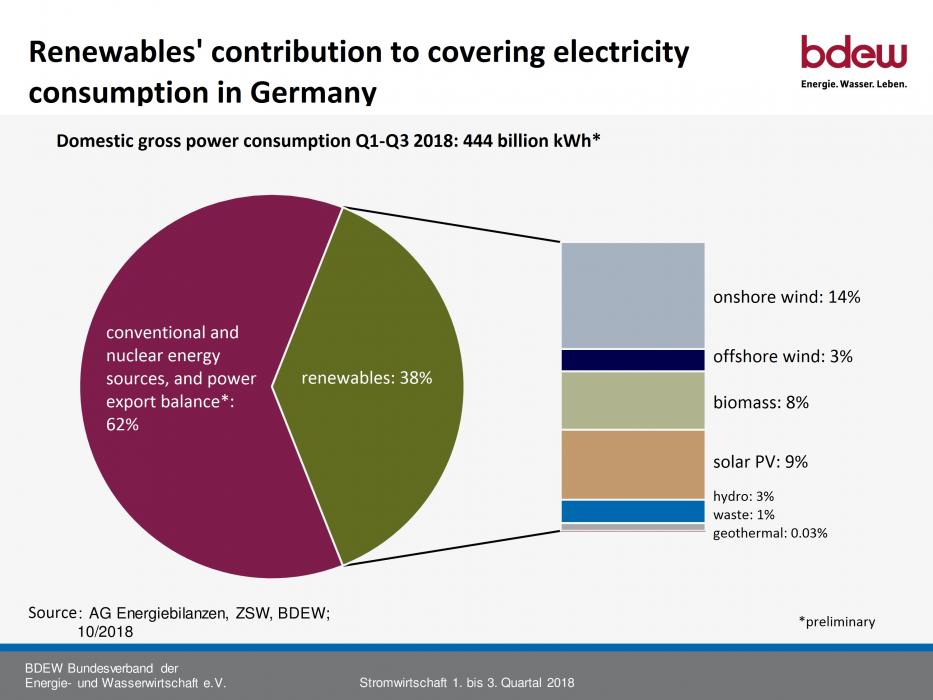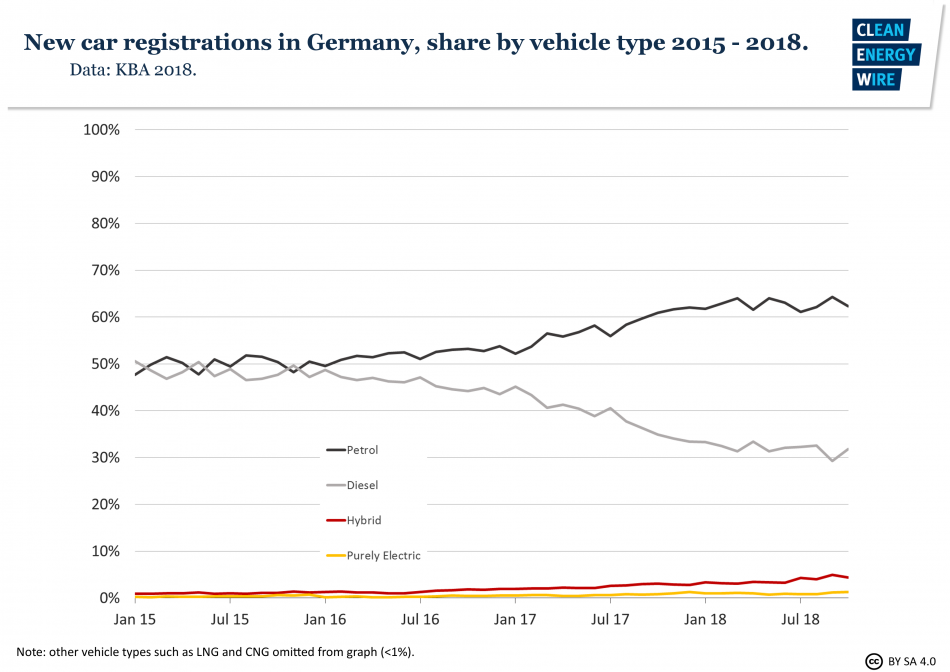Germany’s renewables share rises to 38 percent of power consumption
Utility Association BDEW
Renewables produced 38 percent of the electricity used in Germany between January and September 2018, an increase of three percentage points over a year earlier, according to utility association BDEW. In January, April and May, renewables' share even climbed to 43 percent thanks to strong winds and sunshine. “If we have an average amount of wind in the fourth quarter, renewables could also cover 38 percent over the entire year,” BDEW said. In the first three quarters of the year, renewables produced almost 170 billion kilowatt-hours (kWh), while lignite and hard coal added up to about 172 billion kWh.
“Clearly, renewables are in the fast lane, while the contribution of conventional energy sources to cover gross power consumption is falling continuously. But we still have a lot of work ahead of us to reach the target of a 65 percent renewables share by 2030,” said BDEW head Stefan Kapferer.
Find the press release in German here.
Find background in the article Renewables overtake coal as Germany’s most important power source.
Statistics Office (Destatis)
The energy consumption of German industry remained unchanged in 2017. According to the statistics office Destatis, 87 percent was used “for energetic purposes such as electrcitiy and heat production.” The remaining 13 percent was used for the production of chemical products such as motor fuels, fertilisers or plastics, among others. “As in the previous years, the main energy sources in industry were natural gas (29 percent), electricity (21 percent), coal (17 percent) and mineral oils and mineral oil products (17 percent).”
Find the press release in English here.
pwc
The end of feed-in tariffs for 20-year-old solar PV installations is likely to boost the own consumption of renewable power, according to a study published by management consultancy pwc. “Between 2029 and 2032 – 20 years after the solar boom of 2009-2012 – a particularly large number of solar arrays will lose their support payments . This is why by 2033, operators of more than a million solar arrays in total, with a volume of 24 terawatt-hours (TWh), could push onto the market,” said pwc. Using electricity generated on site will be an attractive option, and installing a battery could further increase own consumption, especially as battery prices are expected to drop sharply. “This is why we expect a strong increase in battery storage sales in the coming years,” said pwc.
Find the press release and study in German here.
Find plenty of background in the dossier Electricity storage is next feat for Germany’s energy transition.
Stuttgarter Nachrichten
Despite the increasing share of renewable power and the agreement on additional renewable actions, Germany’s energy transition has lost momentum, writes the Stuttgarter Nachrichten in an editorial by business correspondent Alexander del Regno. “The Energiewende is more than just a prestige project. Jobs, innovation and export opportunities depend on its success,” writes the newspaper. “ Moreover, it reduces the dependence on fossil resources from totalitarian states like Russia and Saudi-Arabia.”
Find the editorial in German here.
pv magazine
The German government plans to cut support payments for large roof-mounted photovoltaic arrays ranging in size from 40 to 750 kilowatts by around 20 percent at the turn of the year, reports Sandra Enkhardt in pv magazine, with reference to a draft bill by the Federal Ministry of Economics (BMWi). “The proposal surprised the industry as it targets the segment largely responsible for Germany this year having hit its 2.5-gigawatt annual new renewable capacity target for the first time in five years,” writes Enkhardt. “Prices for photovoltaic modules and photovoltaic systems have dropped sharply in recent months,” said the German government in a document supporting the proposed cuts.
Read the article in English here.
Federal Motor Transport Authority (KBA)
The share of pure electric vehicles in Germany’s new car registrations climbed to 1.3 percent in October, as the number of new EVs increased 55 percent year-on-year, according to the Federal Motor Transport Authority (KBA). The share of hybrid cars rose to 4.4 percent, while diesel fell to 31.8 percent and the share of petrol models was 62.3 percent. Average CO2 emissions of new cars rose 2.5 percent to 130.9 grammes per kilometre.
Find the press release in German here.



